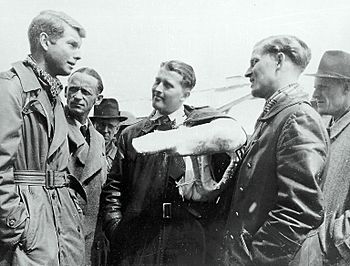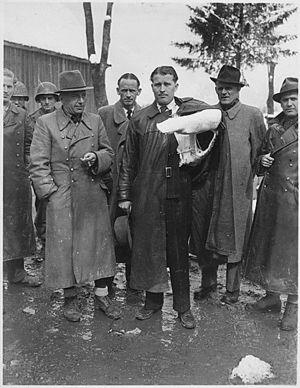Magnus von Braun facts for kids
Quick facts for kids
Magnus von Braun
|
|
|---|---|

Magnus (second from right) and his brother Wernher (center)
|
|
| Born | 10 May 1919 Greifswald, Germany
|
| Died | 21 June 2003 (aged 84) Phoenix, Arizona, U.S.
|
| Alma mater | Technische Universität München |
| Spouse(s) | Hildegard Buchhold (1950–1955) Nathalie "Nan" Heaton-Woodruff (1957–2003) |
| Children | 3 |
| Scientific career | |
| Fields | Aerospace engineering, chemistry |
| Academic advisors | Hans Fischer |
Magnus "Mac" Freiherr von Braun (born May 10, 1919 – died June 21, 2003) was a German chemical engineer and rocket scientist. He also worked as a pilot and a business executive. When he was in his 20s, he helped develop rockets at places like Peenemünde and the Mittelwerk factory in Germany.
At age 26, he moved to the United States. This happened through a special program called Operation Paperclip. He worked for several years at Fort Bliss. In 1955, he started working as a top manager for Chrysler. He first worked in their missile division, then in their car division. He retired in 1975. Magnus von Braun lived in the United States and the United Kingdom for 58 years until he passed away. He was the younger brother of Sigismund von Braun and the famous rocket scientist Wernher von Braun.
Contents
Magnus von Braun's Early Life and Education
Magnus von Braun was born in Greifswald, a town in Pomerania, Germany. His parents were Magnus Freiherr von Braun and Emmy von Quistorp. After finishing boarding school, he began studying at the Technische Universität München in 1937. He earned his master's degree in organic chemistry there. He then became an assistant to Hans Fischer, a scientist who won the Nobel Prize.
Working on Rockets in Germany
Magnus von Braun started working at Peenemünde in July 1943. His brother, Wernher von Braun, asked him to come. In March 1944, he was arrested with other rocket specialists, including his brother Wernher. However, he was later set free. In late 1944, he moved to the Mittelwerk factory. There, he helped build parts for the V-2 rocket. These parts included gyroscopes, servomotors, and turbopumps.
The Mittelwerk was a secret underground factory. It was built inside the Harz Mountains in Germany. This was done to protect it from bombs dropped by British and American planes. The factory had two long tunnels, each about a mile long. Many smaller tunnels connected them. Trains brought materials in and took finished rockets out. This huge underground space was where most German rocket production moved after Peenemünde was bombed in 1943.
Sadly, prisoners from the nearby Mittelbau-Dora concentration camps were forced to work there. These people were treated as slave labor. They were marched into the tunnels every day and made to work by the Nazi SS. The SS was a powerful and cruel group. Over 20,000 prisoners died while working in this factory.
Magnus von Braun started working at Mittelwerk in the fall of 1944. At first, the V-2 rockets made there often failed. People thought it might be because of sabotage. Wernher von Braun, who was still at Peenemünde, sent Magnus to Mittelwerk to help fix these problems. While some small acts of sabotage did happen, the main reason for the poor quality was trying to mass-produce advanced technology using forced labor.
Magnus reported directly to Arthur Rudolph, the chief of rocket production at the factory. This working relationship would continue for many years.
After the War: Moving to the United States
After Germany lost the war in 1945, Magnus von Braun and other German scientists moved to the United States. This was part of Operation Paperclip. The U.S. Army hired them to develop long-range missiles in New Mexico. Later, in the 1960s, Magnus worked for Chrysler Corporation. Chrysler was a main contractor for the Saturn V lunar rocket, which helped send astronauts to the Moon. Arthur Rudolph also continued to work with Magnus at NASA.
Arthur Rudolph was praised for his work on the Saturn V rocket after the moon landing. However, later in his life, people learned more about his role in using slave labor at Mittelwerk during the war. Because of this, Rudolph agreed to give up his U.S. citizenship in 1983 to avoid being charged with crimes. He then returned to Germany.
In November 1944, Magnus was put in charge of the rocket fin servomotors. These were a very difficult part of the V-2 rocket to make. During this time, there were many worries about sabotage. Some Russian prisoners suspected of sabotage were executed that winter.
Magnus von Braun was much younger than his two older brothers. He grew up during the time when the Nazis were in power in Germany. He was 13 when Adolf Hitler became leader. He was part of the Hitler Youth and went to school where the lessons were changed to fit Nazi ideas. This early experience shaped his character.
Surrendering to the Allies

After leaving Nordhausen, Magnus von Braun was in Weilheim when Wernher von Braun arrived there on April 14, 1945. The next day, Magnus was in Oberjoch.
On May 3, 1945, after hearing about Hitler's death, Wernher von Braun told his group that Magnus had left to find American forces. Magnus spoke English, and he rode his bicycle to Reutte. Dr. Ernst Stuhlinger, a member of the V-2 team, said it was very brave for Magnus to go alone with just a white handkerchief tied to his bicycle handlebars.
On May 10, 1919, I was born in Greifswald, the son of a government administrator, Magnus Freiherr von Braun, and his wife, Emmy, née von Quistorp. I spent my youth in Berlin, where I attended the Prep School and the French School until Easter 1934. Finally, I went to the Hermann Lietz School in Spiekeroog, North Sea, a boarding school from which I graduated Easter 1937. After having spent six months in the Arbeitsdienst, I began studies at the Technical Institute of Munich in the fall of 1937, majoring in organic chemistry. Then when I received my master's degree, I became the assistant in organic chemistry to Professor Hans Fischer (Nobel Prize winner in chemistry) for ¼ year, at which time I was drafted into the Air Force (October 1940). After the completion of flight training and a short stay as a flight instructor, I came to the Heimat Artillery Park II, Kalshagen, in July 1943. In Karlshagen, I worked with Mr. Gerhard Heller, the director of fuel chemistry, who put me in charge of hypergolic fuels for the newly developing Wasserfall Project. In this capacity, I worked in conjunction with the I. G. Farben Industry. In October 1943, my brother, Professor Wernher von Braun, requested me to work as his personal assistant.
—Magnus von Braun, document presented to U.S. Army
Around two in the afternoon, Magnus returned. He had safe conduct passes, meaning the Americans wanted to talk to them. Dieter Huzel, who was with the group, described their surrender. On May 2, 1945, seven men, including Magnus and Wernher, started their journey. They met an American soldier who stopped them. Magnus showed him a paper. After a while, they were taken by jeeps to Reutte. The next morning, they had their pictures taken by Army photographers. Magnus joked, "We're celebrating now, but I'll bet they will throw telephone books at us if we ever reach New York."
Working in the United States
Magnus von Braun arrived in New York on November 16, 1945. He soon began working at Fort Bliss in Texas. Later, he worked at Redstone Arsenal in Huntsville, Alabama. He was questioned as a witness in a war crimes trial involving Georg Rickhey, the general manager of Mittelwerk. Rickhey was found not guilty.
Career with Chrysler
In 1955, von Braun started working for Chrysler. He first worked in their missile division, then in the automotive (car) division. He lived in Huntsville, Alabama, for a while before moving to Michigan. Later, he moved to the United Kingdom. There, he worked in London and Coventry as Chrysler UK's export director. Magnus von Braun retired from Chrysler in 1975. He then returned to the United States and settled in Arizona, where he lived until he passed away.

